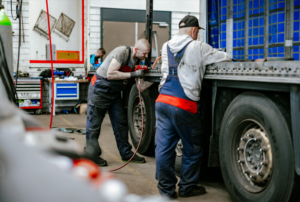How can fleet managers ensure their drivers’ safety? Barney Goffer, UK Product Manager at Teletrac Navman, highlights four key areas managers must consider regarding safety.
For commercial drivers, the cab of their vehicle is their workplace. It’s where they spend significant amounts of time daily and need to be comfortable doing their job safely and effectively. For this reason, driver safety and well-being should be a top priority for employers and employees who spend their workdays behind the wheel.
The first step is to improve comfort and ergonomics. Drivers should always ensure their seat is in an optimal position, their steering wheel is adjusted correctly, and a lumbar cushion or support is used if needed. Additionally, mirrors should be adjusted correctly to reduce back and neck strain. Setting up a cab the right way can help relieve aches and pains throughout the many miles drivers put in during the day and is also essential for a driver’s health and wellness.
A second area to consider is ensuring drivers stay connected and engaged. Efficient communication, real-time updates, and streamlined digital processes simplify administration, free up time for better customer service, and minimise distractions. Drivers stay productive and safe with effective routing and dispatch, while real-time information helps plan routes and resolve issues promptly.
Automating tasks like record-keeping and order processing also minimises manual work, allowing drivers to focus on delivering a great customer experience. By leveraging digital technology, businesses can optimise operations and allocate more resources to providing outstanding service.
A third consideration is for the driver behind the wheel. Drivers need to take care of themselves on the road, so eating healthily, staying hydrated and getting enough rest is essential. It’s also important to take breaks and stretch to avoid fatigue and muscle strain.
Setting off in good time also alleviates stress and reduces the risk of aggressive driving. A well-prepared driver is a safer driver.
Finally, technology can be used to improve driver safety in the cab. One of the ways to accomplish this is using dash cams. With AI-powered real-time feedback and coaching, drivers can be alerted to unsafe driving habits as they occur and can receive individualised training based on the information being gathered.
GPS vehicle tracking and driver status monitoring can also help with driver behaviour monitoring. Unsafe actions like speeding, harsh braking, and mobile phone use can be identified, and drivers can be coached about the risks of these actions. At the same time, driver scorecards can identify and reward safe drivers.
With all these areas to consider, fleet managers can begin to make these changes to ensure safety and compliance. All aspects of the job must be considered to create a better work environment for professional drivers. This includes changes to the workspace and behavioural changes on the driver’s part.




